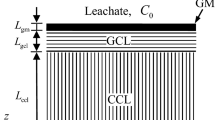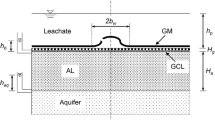Abstract
An analytical solution for one-dimensional contaminant diffusion through multi-layered media is derived regarding the change of the concentration of contaminants at the top boundary with time. The model accounts for the arbitrary initial conditions and the conditions of zero concentration and zero mass flux on the bottom boundary. The average degree of diffusion of the layered system is introduced on the basis of the solution. The results obtained by the presented analytical solutions agree well with those obtained by the numerical methods presented in the literature papers. The application of the analytical solution to the problem of landfill liner design is illustrated by considering a composite liner consisting of geomembrane and compacted clay liner. The results show that the 100-year mass flux of benzene at the bottom of the composite liner is 45 times higher than that of acetone for the same composite liner. The half-life of the contaminant has a great influence on the solute flux of benzene diffused into the underlying aquifer. Results also indicates that an additional 2.9–5.0 m of the conventional (untreated) compacted clay liner under the geomembrane is required to achieve the same level of protection as provided by 0.60 m of the Hexadecyltrimethylammonium (HDTMA)-treated compacted clay liners in conjunction with the geomembrane. Applications of the solution are also presented in the context of a contaminated two-layered media to demonstrate that different boundary and initial conditions can greatly affect the decontamination rate of the problem. The method is relatively simple to apply and can be used for performing equivalency analysis of landfill liners, preliminary design of groundwater remediation system, evaluating experimental results, and verifying more complex numerical models.







Similar content being viewed by others
References
Ahmed AA, Chen D (2006) Effects of contamination age on phenanthrene desorption from aquifers. J Environ Sci Health Part A 41:1–15
Ball WP, Liu C, Xia G, Young DF (1997) A diffusion-based interpretation of tetrachloroethene and trichloroethene concentration profiles in a groundwater aquitard. Water Resour Res 33:2741–2758
Barone FS, Rowe RK, Quigley RM (1992) A laboratory estimation of diffusion and adsorption coefficients for several volatile organics in a natural clayey soil. J Contam Hydrol 10:225–250
Bartelt-Hunt SL, Burns SE, Smith JA (2003) Nonionic organic contaminant sorption onto two organobentonites as a function of organic-carbon content. J Colloid Interface Sci 266:251–258
Bartelt-Hunt SL, Smith JA, Burns SE, Rabideau AJ (2005) Evaluation of granular activated carbon, shale, and two oragaoclays for use as sorptive amendments in clay landfill liners. J Geotech Geoenviron Eng 131:848–856
Bear J (1972) Dynamics of fluid in porous media. Elsevier, New York
Bezza A, Ghomari F (2008) Nondestructive test to track pollutant transport into landfill liners. Environ Geol. doi: 10.1007/s00254-008-1265-5
Booker JR, Rowe RK (1987) One dimensional advective–dispersive transport into a deep layer having a variable surface concentration. Int J Numer Anal Meth Geomech 11:131–142
Du YJ, Hayashi S, Liu SY (2005) Experimental study of migration of potassium ion through a two-layer soil system. Environ Geol 48:1096–1106
Edil TB (2003) A review of aqueous-phase VOC transport in modern landfill liners. Waste Manage 23:561–571
Foose GJ, Benson CH, Edil TB (1999) Equivalency of composite geosynthetic clay liners as a barrier to volatile organic compounds. Geosynthetics99, Industrial Fabric Association International, St. Paul, MN, 321–334
Foose GJ, Benson CH, Edil TB (2001) Analytical equations for predicting concentration and mass flux from composite liners. Geosynth Int 8:551–575
Foose GJ (2002) Transit-time design for diffusion through composite liners. J Geotech Geoenviron Eng 128:590–601
Foose GJ, Benson CH, Edil TB (2002) Comparison of contaminant transport in three composite liners. J Geotech Geoenviron Eng 128:1–13
Freeze RA, Cherry JA (1979) Groundwater. Prentice-Hall, Englewood Cliffs
Gray DH, Weber WJJ (1984) Diffusional transport of hazardous waste leachate across clay barriers. In: Proceedings of 7th Annual Madison Waste Conference Madison, 373–389
Greenberg JA, Mitchell JK, Witherspoon PA (1973) Coupled salt and water flows in a groundwater basin. J Geophys Res 27:6341–6353
Hrapovic L (2001) Laboratory study of intrinsic degradation of organic pollutants in compacted clayey soil. PhD, University of Western Ontario, Canada
Jang YS, Hong GT (2002) Analysis of effective diffusion and transport of inorganic solute through a landfill liner system. Environ Geol 42:929–936
Joo JC, Kim JY, Nam K (2004) Mass transfer of organic compounds in dilute aqueous solutions into high density polyethylene geomembranes. J Environ Eng 130:175–183
Kalbe U, Müller WW, Berger W, Eckardt J (2002) Transport of organic contaminants within composite liner systems. Appl Clay Sci 23:67–76
Kim H, Benson CH (2004) Contributions of advective and diffusive oxygen transport through multi-layer composite caps over mine waste. J Contam Hydrol 71:193–218
Krol MM, Rowe RK (2004) Diffusion of TCE through soil-bentonite slurry walls. Soil Sediment Contam 13:81–101
Lambe TW, Whitman RV (1969) Soil mechanics SI version. John Wiley and Sons, New York
Lee PKK, Xie KH, Cheung YK (1992) A study on one dimensional consolidation of layered systems. Int J Numer Anal Meth Geomech 16:815–831
Leo CJ, Booker JR (1999) A boundary element method for analysis of contaminant transport in porous media-II: non-homogeneous porous media. Int J Numer Anal Meth Geomech 23:1701–1715
Liu HH, Zhang YQ, Zhou Q, Molz FJ (2007) An interpretation of potential scale dependence of the effective matrix diffusion coefficient. J Contam Hydrol 90:41–57
Lu CSJ, Morrrison RD, Stearns RJ (1981) Leachate production and management from municipal landfills: summary and assessment. Land disposal: municipal solid waste. In: Proceedings of 7th annual research symposium-EPA-600/9-81, 1–17
Malusis MA, Shackelford CD (2002) Coupling effects during steady-state contaminant diffusion through a semi-permeable clay membrane. Environ Sci Technol 36:1312–1319
Malusis MA, Shackelford CD (2004) Predicting contaminant flux through a clay membrane barrier. J Geotech Geoenviron Eng 130(5):477–487
Nakayama S, Takagi I, Nakai K, Higashi K (1984) Migration of radionuclide through two-layered geological media. J Nucl Sci Technol 21:139–147
Park E, Zhan H (2001) Analytical solutions of contaminant transport from finite one-, two-, and three-dimensional sources in a finite-thickness aquifer. J Contam Hydrol 53:41–61
Paseka AL, Lqbal MZ, Walters JC (2000) Comparisons of numerical simulation of solute transport with observed experimental data in a silt loam subsoil. Environ Geol 39(9):977–989
Rabideau A, Khandelwal A (1998) Boundary conditions for modeling transport in vertical barriers. J Environ Eng 124(11):1135–1139
Rowe RK, Booker JR (1984) The analysis of pollutant migration in a non-homogeneous soil. Geotechnique 34:601–612
Rowe RK, Caers CJ, Chan C (1993) Evaluation of a compacted till liner test pad constructed over a granular subliner contingency layer. Can Geotech J 30:667–689
Rowe RK, Quigley RM, Brachman RWI, Booker JR (2004) Barrier systems for waste disposal facilities. Spon Press, London
Rowe RK, Mukunoki T, Sangam HP (2005) BTEX diffusion and sorption for a geosynthetic clay liner at two temperatures. J Geotech Geoenviron Eng 131:1211–1221
Selim HM, Davision JM, Rao PSC (1977) Transport of reactive contaminants through multi-layered soils. Soil Sci Soc Am J 41:3–10
Shackelford CD (1990) Transit-time design of earthen barriers. Eng Geol 29(1):79–94
Shackelford CD, Lee JM (2005) Analyzing diffusion by analogy with consolidation. J Geotech Geoenviron Eng 131(11):1345–1359
Thoma GJ, Reible DD, Valsaraj KT, Thibodeaux LJ (1993) Efficiency of capping contaminated sediments in situ. 2. Mathematics of diffusion–adsorption in the capping layer. Environ Sci Technol 27(12):2412–2419
Toupiol C, WillinghamTW ValocchiAJ, Werth CJ, Krapac IG, Stark TD, Daniel DE (2002) Long-term tritium transport through field-scale compacted soil liner. J Geotech Geoenviron Eng 128(8):640–650
Wang XQ, Thibodeaux LJ, Valsaraj KT, Reible DD (1991) Efficiency of capping contaminated sediments in situ. 1. Laboratory scale experiments on diffusion–adsorption in the capping layer. Environ Sci Technol 25(9):1578–1584
Willingham TW, Werth CJ, Valocchi AJ, Krapac IG, Toupiol C, Stark TD, Daniel DE (2004) Evaluation of multidimensional transport through a field-scale compacted soil liner. J Geotech Geoenviron Eng 130(9):887–895
Voudrias EA (2002) The concept of a sorption chemical barrier for improving effectiveness of landfill liners. Waste Manage Res 20:251–258
Zheng C, Bennett GD (1995) Applied contaminant transport modeling. Theory and practice. Van Nonstrand-Reinhold, New York
Zhu B, Gao D, Chen YM (2008) Geomembrane tensions and strains resulting from differential settlement around rigid circular structures. Geotext Geomembranes. doi:10.1016/j.geotexmem.2008.07.001
Acknowledgments
The authors acknowledge the financial support from National Natural Science Foundation of China (Key Program) (No. 50538080) and National Science Fund for Distinguished Young Scholars (No. 50425825). The authors also appreciate the efforts of the editors and the anonymous reviewers who provided constructive suggestions for this paper.
Author information
Authors and Affiliations
Corresponding author
Appendix: Solutions
Appendix: Solutions
A1 solution for ϕ i (z)
The governing equation for the sub-problem for ϕ i (z) is as follows:
The boundary conditions for this problem are as follows:
Obviously, the solution to Eq. 25 satisfying all relevant boundary conditions is:
where P i and Q i can be obtained using the boundary conditions (Eqs. 26–30).
A2 Solution for θ i (z,t)
The governing equation for sub-problem θ i (z, t) can be written as follows:
The boundary conditions for this problem are:
The initial condition is:
The chemical process of diffusion and the process of small-strain consolidation are mathematically analogous because they are both governed by the same form of a second-order partial differential equation (Shackelford and Lee 2005). According to this analogy, using the method described by Lee et al. (1992) for consolidation of layered soil, the solution to Eq. 32 satisfying all relevant conditions can be expressed as follows:
where
The coefficients A mi and B mi in Eq. 41 can be determined by the following recurrence equation:
in which:
The eigenvalues λ m are obtained by finding the roots of the following characteristic equation:
in which
Because the eigenvalues and the coefficients A mi and B mi are calculated directly from Eqs. 45 and 40, respectively, the computation is dramatically simplified and proved to be very efficient (Lee et al. 1992).
Rights and permissions
About this article
Cite this article
Chen, Y., Xie, H., Ke, H. et al. An analytical solution for one-dimensional contaminant diffusion through multi-layered system and its applications. Environ Geol 58, 1083–1094 (2009). https://doi.org/10.1007/s00254-008-1587-3
Received:
Accepted:
Published:
Issue Date:
DOI: https://doi.org/10.1007/s00254-008-1587-3




